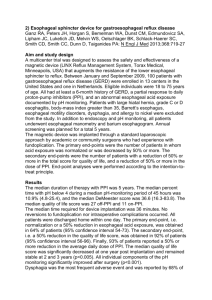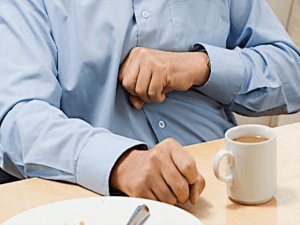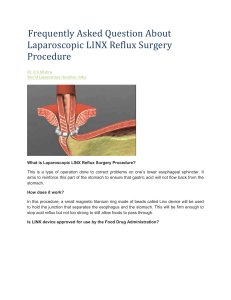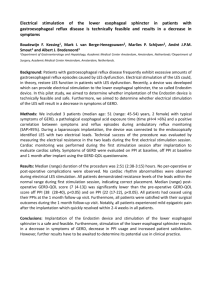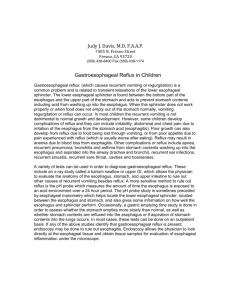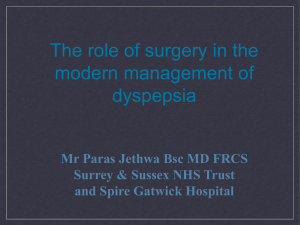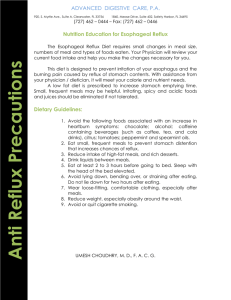- Journal of the American College of Surgeons
advertisement
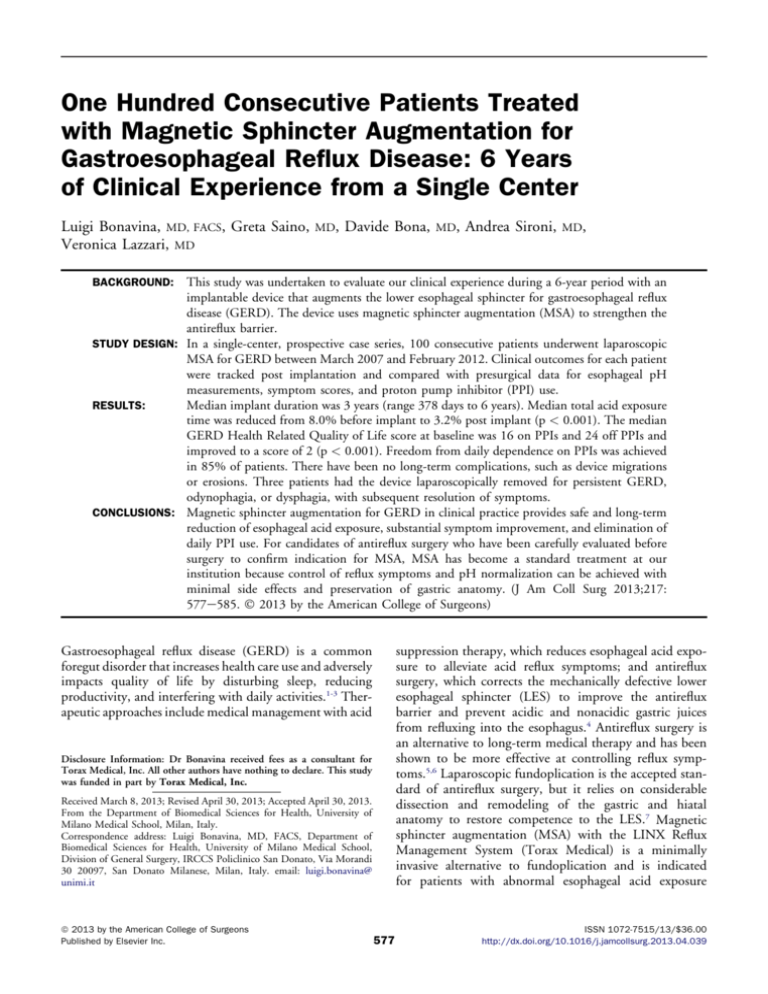
One Hundred Consecutive Patients Treated with Magnetic Sphincter Augmentation for Gastroesophageal Reflux Disease: 6 Years of Clinical Experience from a Single Center Luigi Bonavina, MD, FACS, Greta Saino, Veronica Lazzari, MD MD, Davide Bona, MD, Andrea Sironi, MD, This study was undertaken to evaluate our clinical experience during a 6-year period with an implantable device that augments the lower esophageal sphincter for gastroesophageal reflux disease (GERD). The device uses magnetic sphincter augmentation (MSA) to strengthen the antireflux barrier. STUDY DESIGN: In a single-center, prospective case series, 100 consecutive patients underwent laparoscopic MSA for GERD between March 2007 and February 2012. Clinical outcomes for each patient were tracked post implantation and compared with presurgical data for esophageal pH measurements, symptom scores, and proton pump inhibitor (PPI) use. RESULTS: Median implant duration was 3 years (range 378 days to 6 years). Median total acid exposure time was reduced from 8.0% before implant to 3.2% post implant (p < 0.001). The median GERD Health Related Quality of Life score at baseline was 16 on PPIs and 24 off PPIs and improved to a score of 2 (p < 0.001). Freedom from daily dependence on PPIs was achieved in 85% of patients. There have been no long-term complications, such as device migrations or erosions. Three patients had the device laparoscopically removed for persistent GERD, odynophagia, or dysphagia, with subsequent resolution of symptoms. CONCLUSIONS: Magnetic sphincter augmentation for GERD in clinical practice provides safe and long-term reduction of esophageal acid exposure, substantial symptom improvement, and elimination of daily PPI use. For candidates of antireflux surgery who have been carefully evaluated before surgery to confirm indication for MSA, MSA has become a standard treatment at our institution because control of reflux symptoms and pH normalization can be achieved with minimal side effects and preservation of gastric anatomy. (J Am Coll Surg 2013;217: 577e585. 2013 by the American College of Surgeons) BACKGROUND: suppression therapy, which reduces esophageal acid exposure to alleviate acid reflux symptoms; and antireflux surgery, which corrects the mechanically defective lower esophageal sphincter (LES) to improve the antireflux barrier and prevent acidic and nonacidic gastric juices from refluxing into the esophagus.4 Antireflux surgery is an alternative to long-term medical therapy and has been shown to be more effective at controlling reflux symptoms.5,6 Laparoscopic fundoplication is the accepted standard of antireflux surgery, but it relies on considerable dissection and remodeling of the gastric and hiatal anatomy to restore competence to the LES.7 Magnetic sphincter augmentation (MSA) with the LINX Reflux Management System (Torax Medical) is a minimally invasive alternative to fundoplication and is indicated for patients with abnormal esophageal acid exposure Gastroesophageal reflux disease (GERD) is a common foregut disorder that increases health care use and adversely impacts quality of life by disturbing sleep, reducing productivity, and interfering with daily activities.1-3 Therapeutic approaches include medical management with acid Disclosure Information: Dr Bonavina received fees as a consultant for Torax Medical, Inc. All other authors have nothing to declare. This study was funded in part by Torax Medical, Inc. Received March 8, 2013; Revised April 30, 2013; Accepted April 30, 2013. From the Department of Biomedical Sciences for Health, University of Milano Medical School, Milan, Italy. Correspondence address: Luigi Bonavina, MD, FACS, Department of Biomedical Sciences for Health, University of Milano Medical School, Division of General Surgery, IRCCS Policlinico San Donato, Via Morandi 30 20097, San Donato Milanese, Milan, Italy. email: luigi.bonavina@ unimi.it ª 2013 by the American College of Surgeons Published by Elsevier Inc. 577 ISSN 1072-7515/13/$36.00 http://dx.doi.org/10.1016/j.jamcollsurg.2013.04.039 Bonavina et al 578 Magnetic Sphincter Augmentation Abbreviations and Acronyms GEJ GERD HRQL LES MSA PPI ¼ ¼ ¼ ¼ ¼ ¼ gastroesophageal junction gastroesophageal reflux disease Health Related Quality of Life lower esophageal sphincter magnetic sphincter augmentation proton pump inhibitor confirmed by esophageal pH testing and with chronic symptoms despite maximum medical therapy. The device, a series of magnetic beads connected to each other by independent wires, is implanted via standard laparoscopic techniques around the external tubular esophagus in the area of the LES using minimal dissection technique and without altering the gastric anatomy. We have been using MSA in our clinical practice for 6 years.8,9 We report the clinical outcomes for 100 consecutive patients treated at a single center to provide insights from our long-term experience. METHODS Study population Between March 2007 and February 2012, 100 patients underwent MSA for GERD via laparoscopic surgery at our institution. Patients 1 through 30 (30%) underwent the implantation procedure between March 2007 and May 2008 as part of a multicenter pilot study.10 Patients 31 through 100 (70%) underwent the implantation procedure between December 2009 and February 2012 as part of a registry. Patient selection for the pilot study was per protocol, and patient selection in clinical practice was guided by the manufacturer’s labeling and our experience from the pilot study. Patients were considered for MSA if they were older than18 years of age, had GERD for at least 6 months, had persistent reflux symptoms despite daily proton pump inhibitors (PPIs), and pathologic reflux was confirmed by ambulatory esophageal pH monitoring. In the pilot study, patients were excluded if presurgical screening revealed a hernia 3 cm between the diaphragmatic impression and the top of the gastric rugal folds; erosive esophagitis grade B, C, or D (Los Angeles Classification); body mass index >35; Barrett’s esophagus; motility disorders; gross esophageal anatomic abnormalities; or a known allergy to titanium, stainless steel, nickel, or ferrous materials. Exclusion criteria from the pilot study were largely applied in clinical practice. The protocol for the pivotal study of MSA allowed hiatal hernias of up to 3 cm as well as grade A and B esophagitis, which we adopted as part of our screening criteria in clinical practice. Before surgery, all patients completed esophageal pH testing off PPIs, upper endoscopy, manometry/motility, and a barium esophagram. Patients were excluded from J Am Coll Surg device implant in the pilot study and in clinical practice if manometry showed effective swallows were <70% and the distal amplitude was <35 mmHg. Patients with a known allergy to titanium, stainless steel, nickel, or ferrous materials are contraindicated for MSA. Study design This single-center, prospective case series of consecutive patients evaluated MSA for GERD. Patients were followed after surgery to evaluate the device’s treatment effect and safety. Clinical outcomes at annual intervals for each patient were tracked post implant and compared with presurgical data for esophageal pH measurements, symptom scores, and PPI use. Study evaluations were approved by the Ethics Committee at our institution, and written informed consent was obtained from the patients. Patient assessment All baseline and follow-up data were collected by a surgeon during a telephone call with the patient or during a visit. The assessments for PPI use and nonGERD Health Related Quality of Life (HRQL) symptoms were captured on standardized data collection forms. The GERD-HRQL, a validated assessment tool, was used to evaluate symptoms before and after surgery.11 This questionnaire consists of a total of 10 questions scored on a scale of 0 to 5 (ranging from 0 ¼ no symptoms to 5 ¼ incapacitating symptoms) and 1 nonscored question about satisfaction with present condition (satisfied, neutral, or dissatisfied). Six questions pertain specifically to heartburn; 3 questions pertain to the side effects of dysphagia, odynophagia, and gas bloat; and 1 question pertains to medication use (Fig. 1). At baseline, 30 patients completed the GERD-HRQL when off PPIs and 70 completed it when on PPIs. After surgery, the GERD-HRQL score off PPIs at last follow-up was compared with the total score at baseline and determined to be significant if at least a 50% reduction in score had been achieved. All patients required daily PPIs; therefore, discontinuation of daily PPIs after surgery was considered a measure of success. Additionally, patients were queried before and after surgery for the presence of regurgitation, extraesophageal symptoms, and for the ability to belch or vomit. The pilot study required esophageal pH testing at multiple time points after surgery. Results are reported as of the last follow-up the patient completed for esophageal pH monitoring. A 13-item questionnaire designed to collect information about the referral pathway, patient’s perception, and patient’s satisfaction was administered. The survey Vol. 217, No. 4, October 2013 Bonavina et al Magnetic Sphincter Augmentation 579 Adverse events and complications considered to be possibly related to the device or procedure were tracked and documented. An adverse event was considered serious if it resulted in death, was life threatening, required prolongation of existing hospitalization or required re-hospitalization, resulted in persistent or significant disability, required intervention to prevent permanent impairment or damage, or resulted in fetal distress/death or congenital anatomy or birth defect. Figure 1. GastroEsophageal Reflux DiseaseeHealth Related Quality of Life questions and scoring scale. was done in cooperation with the clinical psychology unit at our institution and was administered only to the registry patients (n ¼ 70). There were 5 specific questions (out of the 13-item questionnaire) that related to this study: 1. 2. 3. 4. 5. Why did you decide to undergo surgery? Where did you learn about LINX, who sent you to us? Would you undergo the operation again? Would you recommend it to a friend? and What have you heard about Nissen fundoplication? Procedure All patients underwent MSA using the LINX Reflux Management System during a laparoscopic procedure. Patients 1 to 30 were treated with the first-generation device that used a Ti-Knot Replacement System (LSI Solutions) to secure the ends of the device around the esophagus. Patients 31 to 100 were treated with the second-generation device. The second-generation device is the same as the firstgeneration device except that the ends of the device are secured with a clasp instead of suture (Fig. 2). Additionally, sizing of the esophagus for the first 30 patients used a colorcoded sizing device of connected beads as described previously.10 With the introduction of the second-generation device, a laparoscopic sizing tool was introduced. The principles of sizing the esophagus remained the same, with the only difference being the tool used. All procedures were performed by 2 surgeons (LB, GS). The standard laparoscopic approach to the gastroesophageal junction (GEJ) was used. We performed minimal dissection to create the space where the device would encircle the LES when implanted. The first step sufficiently exposed the GEJ by applying PEEP and traction on the stomach. Only the peritoneal reflection should be divided, and the mediastinal Figure 2. Magnetic sphincter augmentation. Device with clasp closure to secure ends in annular configuration. 580 Bonavina et al Magnetic Sphincter Augmentation cavity should not be entered. We attempted to preserve the phrenoesophageal ligament in all patients. A posterior crural repair was added only when the hiatus appeared patulous or a sliding hernia was present. Identification and exposure of the posterior vagus nerve and of the area corresponding to the Z-line follows with a small opening being created between the posterior vagus nerve and the esophageal body. This opening helps secure the device from axial movement and confirms location of the device at the Z-line. At this point, a sizing instrument is used to determine the circumferential diameter of the esophagus at the GEJ. This is a critical step to affirm that the magnetic augmentation device size, as determined by the number of beads, exactly matches the external diameter of the sphincter. An appropriately sized device, selected by the surgeon after measuring the tubular esophagus with the manufacturer’s sizing tool, is placed through the opening between the vagus nerve and the esophagus. The ends of the device are then positioned anteriorly and secured. Repair of a patulous hiatus or hiatal hernia was recorded. Any intraoperative complications or difficulties implanting the device were documented. The size of the device placed was also recorded. Postoperative care After surgery, patients were encouraged to eat an unrestricted diet as soon as tolerated. The process of swallowing a solid bolus of food contributes to the expansion of the device, or actuating of the beads during healing. After MSA, patients were asked to reduce their PPI medications to half-dose or to switch to ranitidine 300 mg/d for about 2 weeks and then stop. Patients were instructed to contact the clinic if reflux symptoms returned, or if new symptoms or complications developed after surgery. Statistical analysis Postsurgical data were compared with presurgical data to evaluate treatment effect and included the GERD-HRQL scores, PPI use, and esophageal pH measurements, when available. Continuous demographic and baseline variables were summarized via standard descriptive statistics (eg, mean, SD, median, and range). Categorical demographic and baseline variables were summarized via frequency distributions. The nonparametric Wilcoxon signed rank test was used to compare pre- and post-implant values. Differences were considered significant at the p < 0.05 level. RESULTS Baseline characteristics of patients The first 100 consecutive patients treated with MSA for GERD at our institution were a median of 44.5 years J Am Coll Surg old (range 23 to 77 years) and 74% were male and 26% were female. Median body mass index was 24 (range 17.3 to 33.0). Median number of years with GERD and PPI use was 5.5 and 4.0 years, respectively. Median baseline total GERD-HRQL score off PPIs was 24 (range 10 to 39) and on PPIs was 16 (range 0 to 23). Fifty-three patients had both typical and atypical symptoms, 41 had typical symptoms only, and 6 had atypical symptoms only. Endoscopy showed no esophagitis in 83% of patients, grade A in 10%, grade B in 6%, and grade C in 1%. Two patients had short-segment Barrett’s esophagus treated with radiofrequency ablation before the implant procedure. In the 100 patients included in this report, hernia sizes were as follows: 21 patients had no hernia, 27 had a 1-cm hernia, 34 had a 2-cm hernia, 16 had a 3-cm hernia, and 2 patients had a 4-cm hernia. The 2 patients with a 4-cm hernia were treated later in our experience and met all other screening criteria. No patients had a motility disorder. Median fraction of time of pH <4 in the 100 patients was 7.8% (range 2.3% to 38.2%) and median DeMeester Score was 31.1 (range 11.6 to 123.3). Baseline characteristics by groupings of 25 patients (first, second, third, and fourth groups of implanted patients) are summarized in Table 1. Procedure and discharge The device was successfully implanted in all patients via a laparoscopic approach. Median procedure time was 47 minutes to place the device; this time did not include patient preparation or port placement or removal (Table 2). A crural repair was performed in 44% of patients; a formal mediastinal dissection was required in only 3 patients due to the presence of a type I to III hiatal hernia. There were no intraoperative complications. One patient had a postoperative complication of respiratory arrest within the first hour postoperatively that was not related to the device. The patient was successfully resuscitated and had a full recovery. Chest x-ray and esophagogastroduodenoscopy were performed after the event and showed no adverse effects to device or abnormal findings. Clinical outcomes Median implant duration at time of report was 3 years (range 378 days to 6 years), with 95% (95 of 100) of patients with follow-up data at 1 year (1 year, n ¼ 42; 2 years, n ¼ 8; 3 years, n ¼ 15, and 5 years, n ¼ 30). Symptom improvement and discontinuation of proton pump inhibitor use Median GERD-HRQL score at baseline was 24 off PPIs and 16 on PPIs, and at last follow-up the overall median score off PPIs was reduced to 2 (n ¼ 95). Median heartburn score (questions 1 to 6) was reduced significantly Bonavina et al Vol. 217, No. 4, October 2013 Table 1. Magnetic Sphincter Augmentation 581 Baseline Characteristics by Implant Group Measure Median age, y Male, n Female, n Median BMI Median y with GERD Median y of PPI use Esophagitis, n None Grade A Grade B Grade C Grade D Barrett’s esophagus, n* Hiatal hernia size, n None 1 cm 2 cm 3 cm 4 cm >4 cm Motility disorder, n Median DeMeester score Type of refluxer, n Upright Supine Bipositional NA Group 1, patient nos. 1e25 Group 2, patient nos. 26e50 Group 3, patient nos. 51e75 Group 4, patient nos. 76e100 All patients (N ¼ 100) 45 18 7 24 6 5 39 15 10 22 5 4 45 18 7 24 4 4 33 23 2 25 7 5.5 44.5 74 26 24 5.5 4 18 3 4 0 0 0 22 2 0 1 0 1 22 2 1 0 0 1 21 3 1 0 0 0 83 10 6 1 0 2 8 3 9 5 0 0 0 30.4 3 9 8 4 1 0 0 36.0 2 8 11 4 0 0 0 37.4 8 7 6 3 1 0 0 29.7 21 27 34 16 2 0 0 31.1 12 1 12 0 4 4 17 0 9 4 11 1 10 7 8 0 35 16 48 1 *Short-segment Barrett’s esophagus treated with radiofrequency ablation before magnetic sphincter augmentation. BMI, body mass index; GERD, gastroesophageal reflux disease; PPI, proton pump inhibitor. after LES augmentation when compared with baseline from overall median of 15 to 2 post implant (Fig. 3). Satisfaction with current condition was reported by 87% (83 of 95) of patients at last follow-up compared with 5% (5 of 100) at baseline. A 50% reduction in total GERD-HRQL score at last follow-up, compared with baseline off PPI and on PPI was achieved by 93% of patients (28 of 30, mean follow-up 5 years) and 85% (55 of 65, mean follow-up 1.6 years), respectively. Reports of daily regurgitation dropped from 72% at baseline to 2% at last follow-up, and extra-esophageal symptoms reported as “none” increased from 48% at baseline to 84% at last follow-up (Table 3). As of last follow-up, 85% (81 of 95) reported complete cessation of PPI use for GERD. Clinical outcomes of GERD-HRQL score and PPI use were comparable when looking at implant groups (the order that patients received implants) and reflux type (Figs. 4A, 4B). Esophageal pH monitoring Esophageal pH monitoring after implantation was completed for the pilot study patients only when off PPIs, per protocol. Based on the last esophageal pH test available, mean follow-up time for esophageal pH testing was 4.2 years (1 year, n ¼ 2; 2 years, n ¼ 2; 3 years, n ¼ 4; 4 years, n ¼ 2; and 5 years, n ¼ 20). Median total percent time pH <4 at baseline was 8.0% (range 3.1% to 38.2%) and reduced to 3.2% (range 0.2% to 17.0%) (p < 0.001). Composite median DeMeester Score was 30.1 (range 15.0 to 123.3) at baseline and reduced to 11.2 (range 1.8 to 54.9) (p < 0.001). Other esophageal pH measurements showed major improvements at last follow-up compared with baseline (Table 4). Normalization of pH, defined as total percent time pH <4 for 4.5% was 67% (20 of 30) at last follow-up available and 75% at 5 years (15 of 20). Normalization of esophageal acid exposure or a 50% reduction was achieved by 582 Table 2. Bonavina et al Magnetic Sphincter Augmentation J Am Coll Surg Procedure and Discharge Summary (N ¼ 100) Parameter Procedure time, min, mean SD Overall Patients 1e25 Patients 26e50 Patients 51e75 Patients 76e100 Device size, % of patients 11 beads 12 beads 13 beads 14 beads 15 beads 16 beads 17 beads Length of stay, % of patients <24 h >24 h and <48 h >48 h 46.9 49.6 44.6 44.8 46.8 15.9 18.9 16.1 14.0 14.0 4 33 28 24 10 0 1 70 26 4 80% (25 of 30) of patients, and 87% had a reduction in their acid exposure time after MSA. Patient perception and satisfaction survey Results from the survey are reported in Table 5. The large majority of patients decided to undergo surgery because drug therapy was only partially effective (77%). Fear of cancer (14%) was the next most frequent response, followed by poor quality of life (8%). Most patients (64%) were referred by their physician to have MSA and the others sought out the treatment based on information from the internet or in the press (36%). Figure 4. (A) Clinical outcomes by implant group. Blue line, group 1 (patient nos. 1e25); red line, group 2 (patient nos. 26e50); green line, group 3 (patients 51e75); purple line, group 4 (patients 76e100). (B) Clinical outcomes by reflux type. Blue line, upright; red line, supine; green line, bipositional. GERD-HRQL, gastroesophageal reflux disease Health Related Quality of Life; PPI, proton pump inhibitor. Figure 3. GastroEsophageal Reflux DiseaseeHealth Related Quality of Life score comparison at baseline and last follow-up. Blue bar, baseline off proton pump inhibitor; red bar, baseline on proton pump inhibitor; green bar, last follow-up. Radiologic and endoscopic evaluations There were no abnormal findings on the chest x-ray and barium swallow studies. Median angle of inclination of Side effects Gas bloat, difficulty swallowing, and pain with swallowing were evaluated before and after LES augmentation using responses from the GERD-HRQL. Responses of 3 were considered clinically significant (bothersome every day to incapacitating). There was a reduction in gas bloat, difficulty swallowing, and pain with swallowing after LES augmentation (Table 3). At baseline, 48% of patients reported daily feelings of bloating and at last follow-up this was reduced to 2%. Difficulty swallowing was reported by 8% of patients at baseline and at last follow-up decreased to 0%. Pain with swallowing was reduced from 4% at baseline to 0% at last follow-up. Ability to belch was reported by 99% of patients after treatment, and one patient reported the inability to vomit when needed. Bonavina et al Vol. 217, No. 4, October 2013 Table 3. Symptoms and Side Effects Measure GERD-HRQL, total score* Total score on PPIy Total score off PPIz Regurgitation, % None Mild Moderate Severe Daily episodes Extra-esophageal symptoms, % None Recurrent cough Nocturnal cough Asthma Change of voice Side effects, % Gas bloatx Dysphagiax Odynophagiax Ability to belch Ability to vomit Baseline Magnetic Sphincter Augmentation 583 Table 4. Esophageal pH Measurements Baseline Last follow-up* p Valuey 8.0 9.2 3.5 51.7 4.0 35.3 30.1 3.2 3.8 0.4 31.5 1.0 9.5 11.2 <0.001 <0.001 0.002 0.002 <0.001 0.024 <0.001 Last follow-up Measure 16 24 NA 2 12 26 59 3 72 85 10 5 0 2 48 32 9 9 37 84 11 2 0 2 48 8 4 100 100 2 0 0 99 99 Percentages might not total 100 because of rounding. *Scores range from 0 to 50, with higher scores indicating worse symptoms. y Patients 31 to 100 completed the GERD-HRQL when on PPIs at baseline and off PPIs at follow-up. z Patients 1 to 30 completed the GERD-HRQL when off PPIs at baseline and follow-up. x Percentage of patients reporting a score 3 on the GERD-HRQL for the corresponding question. GERD, gastroesophageal reflux disease; HRQL, Health Related Quality of Life; NA, no assessment completed per protocol at time point; PPI, proton pump inhibitor. the device measured on the chest x-ray was 49.29 degrees (range 18.71 to 89.35 degrees). No esophageal dilation was noted on barium swallow studies. The Hill grade was measured in 15 patients before and after surgery. At the last follow-up, 80% (12 of 15) stayed at Hill grade I or improved, 13% (2 of 15) remained the same, and 1 (7%) patient’s Hill grade was worse. Follow-up endoscopies showed no evidence of device erosion or development of esophagitis. Adverse events During 6 years of clinical experience, no device erosion or migrations have occurred. Three patients had the device removed during a laparoscopic procedure. The first patient underwent device removal 378 days post implant for persistent odynophagia. The explant procedure took approximately 25 minutes and was immediately followed by a Dor fundoplication. The odynophagia resolved post explant with no clinical sequelae. The second patient had Total time pH <4, %z Total upright time, % Total supine time, % Total reflux episodes, n Reflux episodes >5 min, n Longest reflux episode, min DeMeester score *Last follow-up pH measurements for patients 1 through 30 per protocol. y p Values are from Wilcoxon signed rank test for continuous outcomes and McNemar’s test for categorical normalization outcomes. z Percent reported as median. the device removed 771 days post implant for continued GERD symptoms. The patient had a 3-cm hiatal hernia before LES augmentation that was not repaired at the time of device implant. The patient requested removal of the device. The device was laparoscopically explanted and followed by a Toupet fundoplication without complications. The third patient underwent device removal 406 days post implant for persistent dysphagia that did not respond to esophageal dilation. The explant was uneventful and followed by reconstruction of the angle of His with a Lortat-Jacob antireflux procedure. The dysphagia resolved after device removal. The rate of esophageal dilation post implant has been 2% (2 of 100). One patient with dysphagia and odynophagia underwent esophageal dilation 5 days after implant with resolution of symptoms, and the other patient underwent esophageal dilation 335 days post implant for dysphagia that did not resolve, so the device was explanted (as reported in the previous paragraph). Table 5. Responses from Patient Perception and Satisfaction Survey Question Why did you decide to undergo surgery? Where did you learn about LINX, who sent you to us? Would you undergo the operation again? Would recommend it to a friend? What did you hear about Nissen fundoplication? Response % Drug therapy only partially effective 77 Poor quality of life 8 Fear of cancer 14 Referring physician 64 Internet/press 36 Yes No Yes No Effective only in the short-term Too invasive Dysphagia Inability to belch/vomit Not reversible 91 9 94 6 90 90 75 60 41 584 Bonavina et al Magnetic Sphincter Augmentation The patient who underwent dilation on postoperative day 5 was dilated to assess compliance of the GEJ and reassure the patient that the device was functioning properly. The dilation was performed under fluoroscopy to enable visualization of bead actuation during dilation, and it was confirmed that the device responded appropriately when subjected to dilation. In this particular patient, it is unclear if dilation at this early postoperative time point contributed to the resolution of dysphagia. Four patients reported mild chest pain/odynophagia that improved within 4 months after surgery. Three patients had unscheduled office visits for increased belching that required no intervention or medication for resolution of symptoms. A total of 5 patients had surgery for reasons unrelated to the device or implant procedure: 2 patients had coronary artery bypass surgery, 1 had cholecystectomy, 1 had vocal surgery, and another had repair of an aortic aneurysm. Pregnancy and magnetic resonance imaging Three patients have become pregnant with the device implanted. One patient uneventfully delivered her third child and was, for the first time, asymptomatic during her pregnancy. Another patient also carried the baby to full term with no complications or adverse events, and had good control of reflux symptoms during the pregnancy. A third patient is currently pregnant at the time of this report and has not had any issues. During follow-up visits, a total of 8 patients reported undergoing MRI. No serious injuries occurred. All but 2 patients were asymptomatic during and after MRI. The 2 patients reported discomfort during the MRI. The first patient had dysphagia and odynophagia for 3 months that resolved, and the second reports occasional heartburn post MRI. Chest x-ray for both of these patients showed the device in a more open geometry. DISCUSSION When offered alongside fundoplication, all patients but one elected to have MSA instead of fundoplication, showing acceptance of this new treatment. Data collected by questionnaire provided insight into the perceptions held by patients about fundoplication: 90% of patients reported concerns about long-term failure of fundoplication, 75% were concerned about dysphagia, and 41% were concerned about the difficulties reversing a fundoplication if needed. Patient perception of overall success is an important outcome variable.12,13 It has been reported that 59% of dissatisfied patients report new symptoms after fundoplication, such as dysphagia, chest pain, gas bloating, inability to belch and vomit, and nausea, which appear to overshadow the simultaneous improvements in heartburn J Am Coll Surg severity.14 In our experience with the magnetic sphincter device, these side effects were minimal and less than what is expected after fundoplication. An important limitation of the fundoplication procedure has been lack of standardization of the procedure itself. Fundoplications involve a complete or partial wrap, with variations in tightness of the wrap and its length; anatomically, the type of dissection varies by surgeon, including how the vagus nerves and short gastric vessels are managed. The wide variability in technique and the lack of standardized calibration methods contribute to the variable outcomes based on surgeon skill and experience.15 As a consequence, these disadvantages have been cited as the reason adult Nissen fundoplication operations have steadily dropped in the last 10 years in the United States.16 Placement of the magnetic device at the GEJ can be uniformly performed by proper dissection of the tunnel and objective sizing of the distal esophagus, thereby eliminating many of the variables associated with fundoplication. With the standardization of MSA, it is possible that the variability in outcomes observed with traditional antireflux surgery could be reduced substantially. From our experience gained over several years, performing a limited dissection of the GEJ is paramount for optimal implantation of the magnetic sphincter device. The technical skills required to perform minimal dissection of the GEJ are not inferior to the larger, standard dissection associated with Nissen fundoplication, and therefore should be viewed as equivalent in complexity. It could be speculated that once mastered with appropriate proctorship, the MSA procedure has the potential to become much more standardized than other antireflux procedures. The clinical outcomes seen in our clinical practice were comparable with the results from a multicenter, prospective trial for MSA, indicating that a reduction in acid exposure, improvement in quality of life, and elimination of PPI can be achieved in clinical practice.17,18 The consistency of the results among these independent studies supports MSA in selected patients as an important addition to the treatment options available for antireflux surgery. CONCLUSIONS Magnetic sphincter augmentation represents the first major advancement for antireflux surgery in decades, and is a much needed alternative treatment for patients with reflux disease refractory to medical therapy. Patient selection is an important consideration and has contributed to our successful results. Patients with large hernias, motility disorders, advanced esophagitis, previous surgery at the GEJ, and Barrett’s esophagus have not been studied Vol. 217, No. 4, October 2013 under a controlled protocol, so no recommendations or conclusions can be made about safety and efficacy in these patients. The majority of our patients achieved a reduction in distal esophageal acid exposure, sustained symptom improvement, and discontinuation of PPIs with minimal or no side effects, and no substantial or new safety issues have been identified. Patients who are candidates for antireflux surgery should be provided with the option of either MSA or fundoplication when appropriate. Bonavina et al 6. 7. 8. Author Contributions Study conception and design: Bonavina, Saino Acquisition of data: Bonavina, Saino, Bona, Sironi, Lazzari Analysis and interpretation of data: Bonavina, Saino, Bona, Sironi, Lazzari Drafting of manuscript: Bonavina, Saino, Bona, Sironi, Lazzari Critical revision: Bonavina, Saino 12. REFERENCES 13. 1. Dent J, El-Serag HB, Wallander MA, Johansson S. Epidemiology of gastroesophageal reflux disease: a systematic review. Gut 2005;54:710e717. 2. Liker H, Hungin P, Wiklund I. Managing gastroesophageal reflux disease in primary care: the patient perspective. J Am Board Family Pract 2005;18:393e400. 3. Toghanian S, Johnson DA, Stålhammar NO, Zerbib F. Burden of gastro-oesophageal reflux disease in patients with persistent and intense symptoms despite proton pump inhibitor therapy: a post hoc analysis of the 2007 national health and wellness survey. Clin Drug Investig 2011;31:703e715. 4. Stein HJ, Barlow AP, DeMeester TR, Hinder RA. Complications of gastroesophageal reflux disease. Role of the lower esophageal sphincter, esophageal acid and acid/alkaline exposure, and duodenogastric reflux. Ann Surg 1992;216:35e43. 5. Stefanidis D, Hope W, Kohn G, et al. Guidelines for Surgical Treatment of Gastroesophageal Reflux Disease. Society of American Gastrointestinal Endoscopic Surgeons (SAGES) 9. 10. 11. 14. 15. 16. 17. 18. Magnetic Sphincter Augmentation 585 2010;Feb:1e46. Available at: http://www.sages.org/publication/ id/22/. Accessed April 26, 2013. Wileman SM, McCann S, Grant AM, et al. Medical versus surgical management for gastro-oesophageal reflux disease (GORD) in adults. Cochrane Database Syst Rev 2010;13: 332e341. Catarci M, Gentileschi P, Papi C, et al. Evidence-based appraisal of antireflux fundoplication. Ann Surg 2004;23: 325e337. Bonavina L, DeMeester TR, Fockens P, et al. Laparoscopic sphincter augmentation device eliminates reflux symptoms and normalizes esophageal acid exposure: one- and 2-year results of a feasibility trial. Ann Surg 2010;252:857e862. Lipham JC, DeMeester TR, Ganz RA, et al. The LINX reflux management system: confirmed safety and efficacy now at 4 years. Surg Endosc 2012;26:2944e2949. Bonavina L, Saino GI, Bona D, et al. Magnetic augmentation of the lower esophageal sphincter: results of a feasibility clinical trial. J Gastrointest Surg 2008;12:2133e2140. Velanovich V. Comparison of generic (SF-36) vs. disease specific quality-of-life (GERD-HRQL) scales for gastroesophageal disease. J Gastrointest Surg 1998;2:141e145. Oelschlager BK, Ma KC, Soares RV, et al. A broad assessment of clinical outcomes after laparoscopic antireflux surgery. Ann Surg 2012;256:87e94. Richter JE. Gastroesophageal reflux disease treatment: side effects and complications of fundoplication. Clin Gastroenterol Hepatol 2013;11:465e471. Humphries LA, Hernandez JM, Whale C, et al. Causes of dissatisfaction after laparoscopic fundoplication: the impact of new symptoms, recurrent symptoms, and the patient experience. Surg Endosc 2013;27:1537e1545. Dunnington GL, DeMeester TR. Outcome effect of adherence to operative principles of Nissen fundoplication by multiple surgeons. Am J Surg 1993;166:654e658. Finks JF, Wei Y, Brinkmeyer JD. The rise and fall of antireflux surgery in the United States. Surg Endosc 2006;20:1698e1701. Ganz RA, Peters JH, Horgan S, et al. Esophageal sphincter device for gastroesophageal reflux disease. N Engl J Med 2013;368:719e727. US Food and Drug Administration. Summary of safety and effectiveness data: LINX Reflux Management System. Available at http://www.accessdata.fda.gov/cdrh_docs/pdf10/P100049b. pdf. Accessed February 28, 2013.

